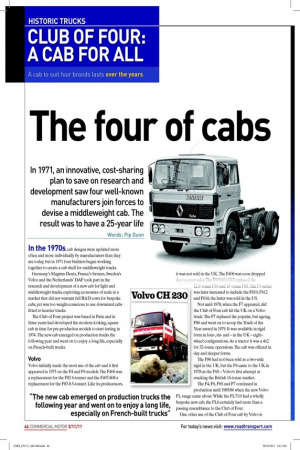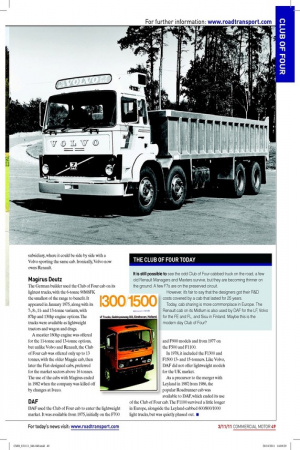The four of cabs
Page 38

Page 40

Page 41

If you've noticed an error in this article please click here to report it so we can fix it.
In 1971, an innovative, cost-sharing plan to save on research and development saw four well-known manufacturers join forces to devise a middleweight cab. The result was to have a 25-year life
Words: Pip Dunn In the 1970s, cab designs were updated more often and more individually by manufacturers than they are today, but in 1971 four builders began working together to create a cab shell for middleweight trucks.
Germany’s Magirus Deutz, France’s Saviem, Sweden’s Volvo and the Netherlands’ DAF took part in the research and development of a new cab for light and middleweight trucks, exploiting economies of scale in a market that did not warrant full R&D costs for bespoke cabs, yet was too weight-conscious to use downsized cabs itted to heavier trucks.
The Club of Four project was based in Paris and in three years had developed the modern-looking, square cab in time for pre-production models to start testing in 1974. The new cab emerged on production trucks the following year and went on to enjoy a long life, especially on French-built trucks.
Volvo
Volvo initially made the most use of the cab and it irst appeared in 1975 on the F4 and F6 models. The F406 was a replacement for the F82 6-tonner and the F407/408 a replacement for the F83 8.5-tonner. Like its predecessors, it was not sold in the UK. The F406 was soon dropped due to poor sales. The F609/611/613 replaced the 12.5-tonne F84 and 15-tonne F85. The F6 series was later increased to include the F610, F612 and F614, the latter was sold in the US.
Not until 1978, when the F7 appeared, did the Club of Four cab hit the UK on a Volvo truck. The F7 replaced the popular, but ageing, F86 and went on to scoop the Truck of the Year award in 1979. It was available in rigid form in four-, sixand – in the UK – eightwheel conigurations. As a tractor it was a 4x2 for 32-tonne operations. The cab was offered in day and sleeper forms.
The F86 had not been sold as a two-axle rigid in the UK, but the F6 came to the UK in 1978 as the F6S – Volvo’s irst attempt at cracking the British 16-tonne market.
The F4, F6, F6S and F7 continued in production until 1985/86 when the new Volvo FL range came about. While the FL7/10 had a wholly bespoke new cab, the FL6 certainly had more than a passing resemblance to the Club of Four.
One other use of the Club of Four cab by Volvo is worthy of mention – the CH230. At the time, Swiss legislation was more complicated than other countries’ and most mass-produced trucks would not legally meet the country’s operators’ needs. A maximum width of 2.3m, plus a maximum gross weight of just 28 tonnes, combined with a minimum power-to-weight ratio of 10hp to the tonne, presented many manufacturers with a market that was not easy to meet.
Volvo came up with a compromise in the CH230; an F7 cab on an F12 drivetrain, giving the beneits of the 12-litre 330hp engine with a light tare weight. In total, 779 were hand built at Irvine from 1980 to 1986, as rigids and tractors.
The Club of Four cabs on the Volvos had reinforcement to meet stringent Swedish crashworthiness laws, making them heavier, which affected Volvo’s ability to compete in the 7.5-tonne market and perhaps explains why Volvo used the cab to greater effect on heavier trucks.
Saviem and Renault
Saviem used the cab on its J series from 7.5-13 tonnes and on its heavier HB range up to 26 tonnes. When Saviem and Berliet merged with Renault in 1978, the cab was retained and expanded onto heavier trucks. Like Volvo, Renault exploited the sleeper version and under French ownership the cab had many facelifts over the years.
First up was the G series, which had 18and 26-tonne 4x2 and 6x4 rigids and tractors up to 38 tonnes. It was still retained for the 7.5-tonne JK65/75/85 series and the S series 13-tonner.
In 1986, the cab also formed the basis of the C series conventional trucks, replacing the old Berliet cab from the 1960s. This conventional cab was also available as a sleeper and on tractor units.
Into the early 1990s, Renault was still using the cab for its Manager rigids and tractors, its Maxter multi-wheeler rigids and its Midliner lightweights.
It was not until 1998 when the new Renault Midlum appeared – using the same cab shell as the Premium that had been launched two years earlier – that the Midliner and Club of Four cab were inally dropped from mainstream production.
Renault last used the cab in America on its Mack subsidiary, where it could be side by side with a Volvo sporting the same cab. Ironically, Volvo now owns Renault.
Magirus Deutz
The German builder used the Club of Four cab on its lightest trucks, with the 6-tonne 90M6FK the smallest of the range to beneit. It appeared in January 1975, along with its 7-, 8-, 11and 13-tonne variants, with 87hp and 130hp engine options. The trucks were available as lightweight tractors and wagon and drags.
A meatier 160hp engine was offered for the 11-tonne and 13-tonne options, but unlike Volvo and Renault, the Club of Four cab was offered only up to 13 tonnes, with the older Maggie cab, then later the Fiat-designed cabs, preferred for the market sectors above 16 tonnes.
The use of the cabs with Magirus ended in 1982 when the company was killed off by changes at Iveco.
DAF
DAF used the Club of Four cab to enter the lightweight market. It was available from 1975, initially on the F700 and F900 models and from 1977 on the F500 and F1100.
In 1978, it included the F1300 and F1500 13and 15-tonners. Like Volvo, DAF did not offer lightweight models for the UK market.
As a precursor to the merger with Leyland in 1987, from 1986, the popular Roadrunner cab was
available to DAF, which ended its use of the Club of Four cab. The F1100 survived a little longer in Europe, alongside the Leyland-cabbed 600/800/1000 light trucks, but was quietly phased out. ■













































